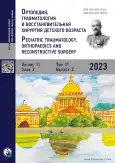“Human tail”: Case reports of coccyx retroposition in children
- Authors: Trofimova S.I.1, Buklaev D.S.1, Murashko T.V.1
-
Affiliations:
- H. Turner National Medical Research Center for Children’s Orthopedics and Trauma Surgery
- Issue: Vol 11, No 2 (2023)
- Pages: 209-217
- Section: Clinical cases
- URL: https://journal-vniispk.ru/turner/article/view/264676
- DOI: https://doi.org/10.17816/PTORS397591
- ID: 264676
Cite item
Abstract
BACKGROUND: A “human tail” is a rare congenital malformation that corresponds to the protrusion on the dorsal side of the lumbar, sacrococcygeal, and paraanal regions. This study aimed to demonstrate three rare clinical cases of a tail-shaped formation caused by the protrusion of an elongated coccyx in children.
CLINICAL CASES: These patients asked for medical assistance for pain felt in the sitting position and daily discomfort because this formation barely contains any tissues other than the coccyx. The patients had no signs of neurological and lower urinary tract insufficiency. In all cases, the retroposition of the coccyx without its typical anterior angulation was determined based on radiographic and magnetic resonance imaging (MRI) signs. In one case, the coccyx was represented by four elongated vertebrae without a typical decrease in the size of the vertebrae in the caudal direction. In two cases, an angular deformity of the coccyx occurred at the level of CoIII with intercoccygeal angles of 138° and 140°.
DISCUSSION: The tail-like formations could be classified as “pseudo-tails” according to the classification by Dao and Netsky (1984) and type Ia “human tails” according to the classification by Tojima and Yamada (2020).
CONCLUSIONS: The most important feature of tail-shaped formation is the connection with occult dysraphic malformations, which requires a comprehensive preoperative examination in each case (neurological examination, radiography, computed tomography, and MRI). Careless surgery may lead to serious consequences that significantly impair patients’ quality of life.
Full Text
##article.viewOnOriginalSite##About the authors
Svetlana I. Trofimova
H. Turner National Medical Research Center for Children’s Orthopedics and Trauma Surgery
Email: trofimova_sv2012@mail.ru
ORCID iD: 0000-0003-2690-7842
SPIN-code: 5833-6770
Scopus Author ID: 57193275907
MD, PhD, Cand. Sci. (Med.)
Russian Federation, Saint PetersburgDmitry S. Buklaev
H. Turner National Medical Research Center for Children’s Orthopedics and Trauma Surgery
Email: dima@buklaev.com
ORCID iD: 0000-0003-1868-3703
SPIN-code: 4640-6856
MD, PhD, Cand. Sci. (Med.)
Russian Federation, Saint PetersburgTatiana V. Murashko
H. Turner National Medical Research Center for Children’s Orthopedics and Trauma Surgery
Author for correspondence.
Email: popova332@mail.ru
ORCID iD: 0000-0002-0596-3741
SPIN-code: 9295-6453
MD, radiologist
Russian Federation, Saint PetersburgReferences
- Dao AH, Netsky MG. Human tails and pseudotails. Hum Pathol. 1984;15(5):449–453. doi: 10.1016/s0046-8177(84)80079-9
- Giri PJ, Chavan VS. Human tail: a benign condition hidden out of social stigma and shame in young adult – a case report and review. Asian J Neurosurg. 2019;14(1):1–4. doi: 10.4103/ajns.AJNS_209_17
- Hamoud K, Abbas J. A tale of pseudo tail. Spine. 2011;36(19):E1281–E12814. doi: 10.1097/BRS.0b013e31820a3dd9
- Lin PJ, Chang YT, Tseng HI, et al. Human tail and myelomeningocele. Pediatr Neurosurg. 2007;43(4):334–337. doi: 10.1159/000103318
- Cai C, Shi O, Shen C. Surgical treatment of a patient with human tail and multiple abnormalities of the spinal cord and column. Adv Orthop. 2011;2011. doi: 10.4061/2011/153797
- Tojima S, Yamada S. Classification of the “human tail”: Correlation between position, associated anomalies, and causes. Clin Anat. 2020;33(6):929–942. doi: 10.1002/ca.23609
- Katsuno S, Horisawa M. A case of perianal human tail. J Jpn Soc Pediatr Surg. 2008;44:808–813.
- Saka R, Hasegawa T, Sonobe H. A case of perianal human tail. Journal of Japanese College of Surgeons. 2010;35:85–88.
- Falzoni P, Boldorini R, Zilioli M, et al. The human tail. Report of a case of coccygeal retroposition in childhood. Minerva Pediatr. 1995;47(11):489–491.
- Mohammad Bashir, Davlicarov MA, Cybin AA, et al. Istinnyj hvost s distal’nym udvoeniem u novorozhdennogo. Detskaya hirurgiya. 2015;19(4):53–54. (In Russ.)
- Wilkinson CC, Boylan AJ. Proposed caudal appendage classification system; spinal cord tethering associated with sacrococcygeal eversion. Childs Nerv Syst. 2017;33(1):69–89. doi: 10.1007/s00381-016-3208-x
- Ersahin Y, Gezen F, BedÜk AB. Neuroectodermal appendage: a case report and review. Turkish Neurosurgery. 1993;3:25–27.
- Iqbal Z, Cejudo-Martin P, de Brouwer A, et al. Disruption of the podosome adaptor protein TKS4 (SH3PXD2B) causes the skeletal dysplasia, eye, and cardiac abnormalities of Frank-Ter Haar syndrome. Am J Hum Genet. 2010;86(2):254–261. doi: 10.1016/j.ajhg.2010.01.009
- Sirmaci A, Walsh T, Akay H, et al. MASP1 mutations in patients with facial, umbilical, coccygeal, and auditory findings of Carnevale, Malpuech, OSA, and Michels syndromes. Am J Hum Genet. 2010;87(5):679–686. doi: 10.1016/j.ajhg.2010.09.018
Supplementary files


















